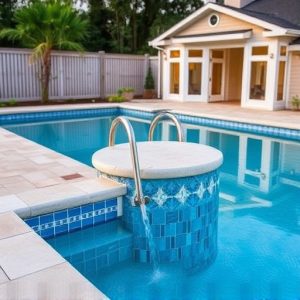Securing Your Inground Pool: Alarms and Safety Measures
Inground pools require specialized safety measures, with swimming pool alarms tailored for these env…….
Inground pools require specialized safety measures, with swimming pool alarms tailored for these environments offering crucial early warnings against drowning, unauthorized access, and equipment theft. These alarms utilize diverse technologies like contact mats, pressure sensors, wave detectors, and smartphone integration to monitor both water surface and perimeter activities. Regular maintenance and staying current with technological advancements ensure optimal protection.
“Ensure peace of mind around your in-ground pool with a robust security strategy. This comprehensive guide delves into the essential aspect of pool security, focusing on understanding potential risks and implementing effective solutions. From identifying vulnerabilities unique to in-ground pools to exploring advanced swimming pool alarms, you’ll discover best practices for safeguarding loved ones. Learn how to choose the right alarm systems tailored for these specialized water bodies, and maintain a safe environment throughout the year.”
Understanding Inground Pool Security Risks
Inground pools present unique security challenges compared to above-ground models, primarily due to their location and design. Understanding these risks is crucial for ensuring safety, especially in cases where a pool is left unattended or during after-hours access. Swimming pool alarms for inground pools are an essential tool for mitigating these dangers, offering a robust early warning system against unauthorized entry or potential accidents.
Key security risks include drowning accidents, unsupervised access, and even attempted theft of pool equipment. Inground pools can be difficult to see from the surface, making them susceptible to accidental falls or clandestine entries. Swimming pool alarms address these issues by monitoring both the water’s surface and the area around the pool perimeter, alerting homeowners or guards instantly upon detection of unusual activity. This proactive approach significantly enhances safety measures for all users, ensuring that any potential danger is quickly addressed.
Types of Swimming Pool Alarms for Inground Pools
Swimming pool alarms for inground pools come in various types, each designed to offer different levels of protection and peace of mind. One common type is the contact mat or sensor alarm that detects movement across its surface. These are often placed around the pool’s edge, triggering an alert when someone steps on them. Another option is the pressure-sensitive alarm that monitors changes in water pressure; if a person enters the pool without activating the pump, it will sound off to warn of potential danger.
For more advanced security, many inground pools incorporate wave or current sensors that detect unusual movements within the water’s surface. These smart alarms can differentiate between normal splashing and potential drowning incidents. Some systems even integrate with home automation networks, allowing remote monitoring and control via smartphone apps. This comprehensive approach to swimming pool alarms for inground pools ensures that both homeowners and guests are safe while enjoying the aquatic facilities.
Implementing and Maintaining Effective Safety Measures
Implementing robust safety measures is paramount when it comes to owning an in-ground swimming pool. One crucial component that often goes unnoticed is the installation of swimming pool alarms. These devices serve as a first line of defense, alerting homeowners and neighbors immediately upon unauthorized access or potential dangers. Modern alarms are designed to be discreet yet highly sensitive, detecting both movement around the pool area and specific activities like diving or splashing.
Regular maintenance is equally vital. Like any security system, swimming pool alarms require periodic checks and calibration to ensure they function optimally. This includes testing sensors, battery backups, and ensuring clear lines of sight. Additionally, updating software and keeping up with technological advancements in pool alarm systems can further enhance safety by incorporating features like remote monitoring and automatic emergency notifications.


